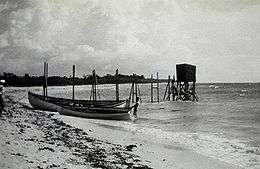Fuga Island
Fuga Island is an island north of Luzon, part of the Babuyan Archipelago, which is the second-northernmost island group of the Philippines. It has an area of 70 square kilometres (27 sq mi)[1] and a population of 2,015 persons.[3] The principal settlement is Naguilian (Musa) village on the southern coast. The highest peak is Mount Nanguringan in the northeast, with an elevation of 191 metres (627 ft).[2]
 Fuga Island tide gauge in 1927 | |
.svg.png) Fuga Island Location within the Philippines | |
| Geography | |
|---|---|
| Coordinates | 18°52′21″N 121°22′44″E |
| Archipelago | Babuyan Islands |
| Adjacent bodies of water | Babuyan Channel |
| Area | 70 km2 (27 sq mi)[1] |
| Highest elevation | 191 m (627 ft)[2] |
| Highest point | Mount Nanguringan |
| Administration | |
| Region | Cagayan Valley |
| Province | Cagayan |
| Municipality | Aparri |
| Demographics | |
| Population | 2,015 (2015)[3] |
Along with the neighbouring islets of Barit (7 square kilometres (2.7 sq mi)) and Mabag,[4] it constitutes one of 42 barangays of the municipality of Aparri, Cagayan. It is the only island of the Babuyan Archipelago under the jurisdiction of a mainland municipality, whereas all other islands form the municipality of Calayan.
Presently, Fuga Island is owned by Fuga Island Holdings. It was formerly owned by the Dominican Order under the encomienda system during the Spanish period eventually returned to the Filipinos after the signing of The Treaty of Paris. The first land title was issued in 1908 under Original Certificate Title number two, and the government of the Philippines designated the island and surrounding ports an economic zone as part of the Cagayan Special Economic Zone (CEZA) and Freeport under Republic Act No. 7922.[5]
Archaeology
From January 31, 1978 to February 22, 1978, Bryan E. Snow and Richard Shutler, Jr. conducted an archaeological excavation on Fuga Moro Island. Only earthenware, pottery, porcelains, and stoneware were found during the excavation.[6]
See also
References
- Genevieve Broad; Carl Oliveros. "Biodiversity and conservation priority setting in the Babuyan Islands, Philippines" (PDF). The Technical Journal of Philippine Ecosystems and Natural Resources 15 (1&2): 1-30. Retrieved 18 April 2018.
- "NE 51-5 Laoag". Series S501, U.S. Army Map Service, 1954-. The University of Texas at Austin. Retrieved 18 April 2018.
- Census of Population (2015). "Region II (Cagayan Valley)". Total Population by Province, City, Municipality and Barangay. PSA. Retrieved 20 June 2016.
- Google (1 February 2020). "Fuga Island" (Map). Google Maps. Google. Retrieved 1 February 2020.
- "Republic Act No. 7922: An act establishing a special economic zone and free port in the municipality of Santa Ana and the neighboring islands in the municipality of Aparri, province of Cagayan, providing funds therefor, and for other purposes" (PDF). ceza.gov.ph. Congress of the Philippines. February 24, 1995. Retrieved 18 April 2018.
- Bryan E. Snow and Richard Shutler, Jr. (1985). "The Archaeology of Fuga Moro Island:New Approaches for the Isolation and Explanation of Diagnostic Ceramic Assemblages in Northern Luzon". University of San Carlos.CS1 maint: uses authors parameter (link)